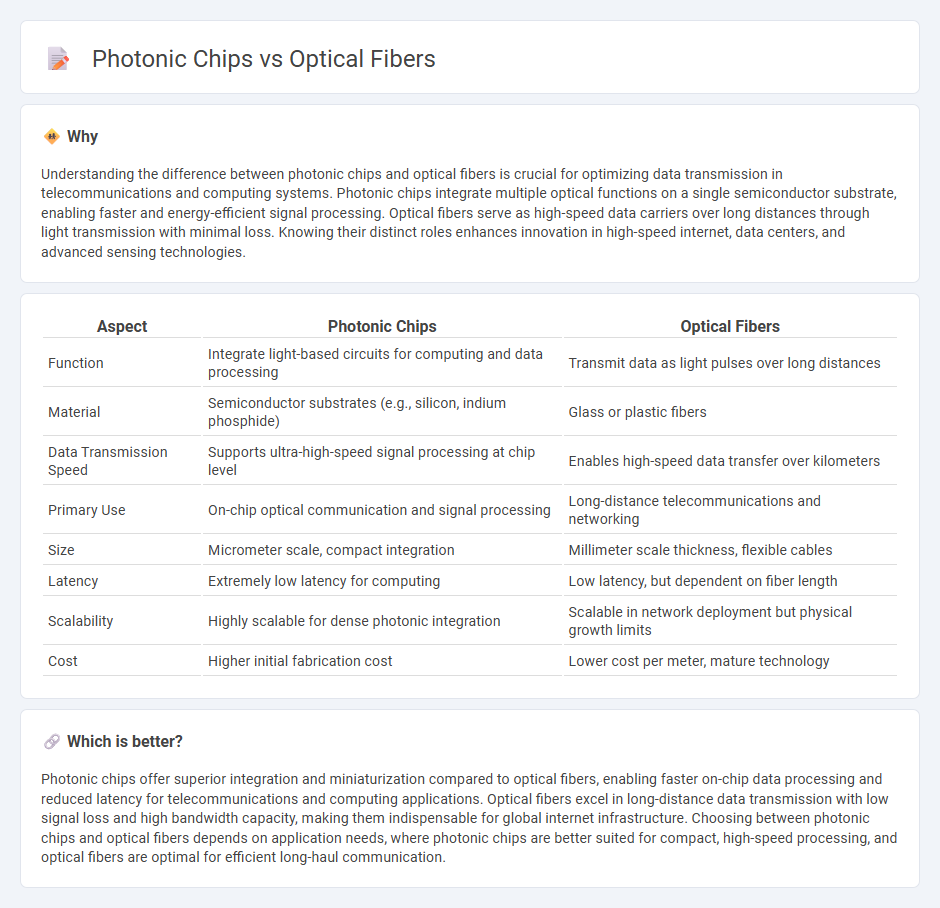
Photonic chips and optical fibers are revolutionizing data transmission by harnessing the power of light for faster and more efficient communication. Photonic chips integrate optical components on a single microchip, enabling high-speed data processing with reduced energy consumption, while optical fibers provide long-distance data transfer through flexible, low-loss glass strands. Explore the distinct advantages and applications of photonic chips versus optical fibers to understand their transformative impact on modern technology.
Why it is important
Understanding the difference between photonic chips and optical fibers is crucial for optimizing data transmission in telecommunications and computing systems. Photonic chips integrate multiple optical functions on a single semiconductor substrate, enabling faster and energy-efficient signal processing. Optical fibers serve as high-speed data carriers over long distances through light transmission with minimal loss. Knowing their distinct roles enhances innovation in high-speed internet, data centers, and advanced sensing technologies.
Comparison Table
| Aspect | Photonic Chips | Optical Fibers |
|---|---|---|
| Function | Integrate light-based circuits for computing and data processing | Transmit data as light pulses over long distances |
| Material | Semiconductor substrates (e.g., silicon, indium phosphide) | Glass or plastic fibers |
| Data Transmission Speed | Supports ultra-high-speed signal processing at chip level | Enables high-speed data transfer over kilometers |
| Primary Use | On-chip optical communication and signal processing | Long-distance telecommunications and networking |
| Size | Micrometer scale, compact integration | Millimeter scale thickness, flexible cables |
| Latency | Extremely low latency for computing | Low latency, but dependent on fiber length |
| Scalability | Highly scalable for dense photonic integration | Scalable in network deployment but physical growth limits |
| Cost | Higher initial fabrication cost | Lower cost per meter, mature technology |
Which is better?
Photonic chips offer superior integration and miniaturization compared to optical fibers, enabling faster on-chip data processing and reduced latency for telecommunications and computing applications. Optical fibers excel in long-distance data transmission with low signal loss and high bandwidth capacity, making them indispensable for global internet infrastructure. Choosing between photonic chips and optical fibers depends on application needs, where photonic chips are better suited for compact, high-speed processing, and optical fibers are optimal for efficient long-haul communication.
Connection
Photonic chips enable high-speed data processing by manipulating light signals, which are transmitted through optical fibers for long-distance communication with minimal loss. Optical fibers act as the physical medium, channeling photons generated and modulated by photonic chips across vast networks with superior bandwidth and low latency. The integration of photonic chips and optical fibers forms the foundation of modern telecommunication systems, supporting rapid data transfer and efficient signal processing.
Key Terms
Light Transmission
Optical fibers enable long-distance light transmission with minimal loss through total internal reflection, making them ideal for telecommunications and data networks. Photonic chips leverage integrated waveguides and nanostructures to manipulate light at a microscopic scale, enhancing processing speed and miniaturization in optical circuits. Explore further to understand how these technologies revolutionize light transmission in modern applications.
Integration Density
Photonic chips offer significantly higher integration density compared to optical fibers by enabling complex light manipulation on a compact semiconductor substrate, allowing for thousands of optical components to be integrated within a few square millimeters. Optical fibers, while excellent for long-distance data transmission, are limited in integration density due to their physical size and configuration, making them less suitable for on-chip applications. Explore more to understand how integration density impacts the performance and scalability of photonic systems.
Data Bandwidth
Optical fibers deliver exceptionally high data bandwidth by transmitting light signals over long distances with minimal loss, reaching terabits per second in modern telecommunication networks. Photonic chips, integrating optical components at the microscale, enable ultra-fast data processing and routing on a compact platform, enhancing bandwidth density and energy efficiency in data centers. Explore the latest advancements in optical fibers and photonic chip technology to understand their impact on next-generation high-bandwidth communication systems.
Source and External Links
Optical fiber - Wikipedia - Optical fibers are flexible glass or plastic fibers transmitting light via total internal reflection, widely used in communications for long-distance, high-bandwidth data transfer due to their immunity to electrical interference and electrical isolation benefits.
Fiber Optics: Understanding the Basics - Photonics Spectra - Optical fibers, about the diameter of a human hair made from glass or plastic, transmit light signals with higher bandwidth, electrical isolation, immunity to EMI, low power loss, and lighter weight compared to metallic conductors, serving applications in telecommunications, LANs, industrial control, avionics, military, and sensing.
What are Fiber Optics and How Do They Work? - Coherent - Optical fibers are thin strands of glass or plastic that transmit light over long distances with low loss, operating by confining light in a core surrounded by cladding with a lower refractive index, enabling flexible deployment in telecommunications, medical, sensing, and industrial laser systems.
 dowidth.com
dowidth.com